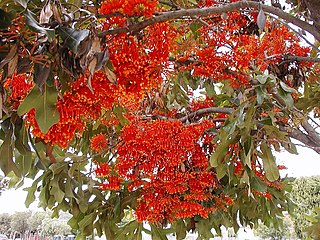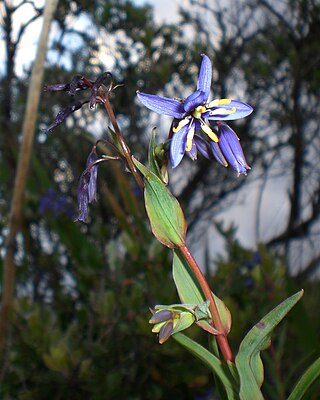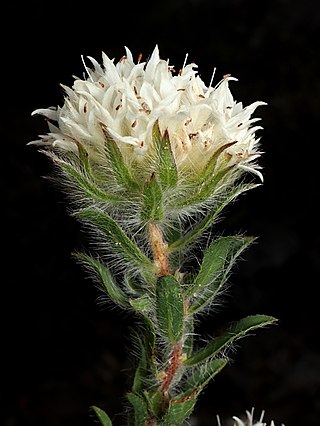
Stenocarpus is a genus of about 22 species of flowering plants in the family Proteaceae. They are trees or shrubs with variably-shaped leaves, zygomorphic, bisexual flowers, the floral tube opening on the lower side before separating into four parts, followed by fruit that is usually a narrow oblong or cylindrical follicle.

Spinifex longifolius, commonly known as beach spinifex, is a perennial grass that grows in sandy regions along the seacoast. It also lives in most deserts around Australia.

Stypandra glauca, commonly known as nodding blue lily, is a flowering plant in the family Asphodelaceae. It is a rhizomatous perennial plant with blue lily-like flower with yellow stamens. It is widespread across southern areas of Australia.
Xerochloa is a genus of Australian and Southeast Asian plants in the grass family.

Anisomeles is a genus of herbs of the family Lamiaceae and is native to China, the Indian Subcontinent, Southeast Asia, New Guinea, Australia, Madagascar, and some Pacific and Indian Ocean islands. Plants in the genus Anisomeles have small, flat, narrow elliptic to narrow e.g.-shaped leaves arranged in opposite pairs, the edges of the leaves sometimes wavy or serrated. The flowers are arranged in groups, with five sepals and five petals in two "lips", the lower lip with three lobes, the middle lobe much longer than the side lobes. There are four stamens that extend beyond the petals and a single style in a depression on top of the ovary. The fruit is a schizocarp with four nutlets containing small seeds.

Johnsonia is a genus five species of herbs in the family Asphodelaceae, all of which are endemic to the south-west of Western Australia. They are grass-like plants with minute flowers surrounded by bracts which are often tinged with white, pink or cream.

Haemodorum is a genus of herbs in the family Haemodoraceae, first described as a genus in 1798 by James Edward Smiith. The genus is native to New Guinea and Australia. The type species is Haemodorum corymbosum Vahl, first described by Martin Vahl in 1805.

Stenanthera is a genus of flowering plants in the family Ericaceae. Most are low shrubs with leaves that are paler on the lower surface, tube-shaped flowers and with the fruit a drupe. There are three species, formerly included in the genus Astroloma.

Schizaea rupestris is a small Australian fern. Most populations are in found in the ranges near Sydney. However, it also occurs near Woolgoolga and Western Australia.

Pimelea imbricata is a species of flowering plant in the family Thymelaeaceae and is native to the southwest of Western Australia and south-eastern South Australia. It is a shrub with narrowly elliptic leaves and erect, compact clusters of white or pink flowers surrounded by 10 to 22 green or red to purple involucral bracts.

Cuscuta australis, commonly known as Australian dodder, is a herb in the family Convolvulaceae.
Cyperus pulchellus is a sedge of the family Cyperaceae that is native to northern Australia, tropical Africa, northwest Madagascar and Southeast Asia.

Alternanthera denticulata is a small prostrate white-flowering herb in the Amaranthaceae family. It is native to all states and territories of Australia, New Guinea, and the North Island of New Zealand. It is also one of the food plants of the varied eggfly, Hypolimnas bolina nerina.

Chaetanthus aristatus is a species of rush. It is found in Western Australia.

Samolus junceus in the family Primulaceae is a species of water pimpernel native to Western Australia.

Westringia rigida is a shrub in the Lamiaceae family that is endemic to Australia. and

Phlebocarya ciliata is a plant in the Haemodoraceae family, native to Western Australia.

Tremulina tremula is a plant in the Restionaceae family, found in the south-west of Western Australia.

Schoenus pedicellatus is a species in family Cyperaceae, first described by Robert Brown in 1810 as Chaetospora pedicellata, but assigned to the genus, Schoenus, in 1811 by Jean Louis Marie Poiret. Note that GBIF and Plants of the World Online both give the genus change as being by Roem. & Schult. However the species is Australian and the text by Poiret is earlier than that of Roemer and Schultes.

Haemodorum simplex is a plant in the Haemodoraceae family, native to the south west of Western Australia, and was first described by John Lindley in 1840.



















